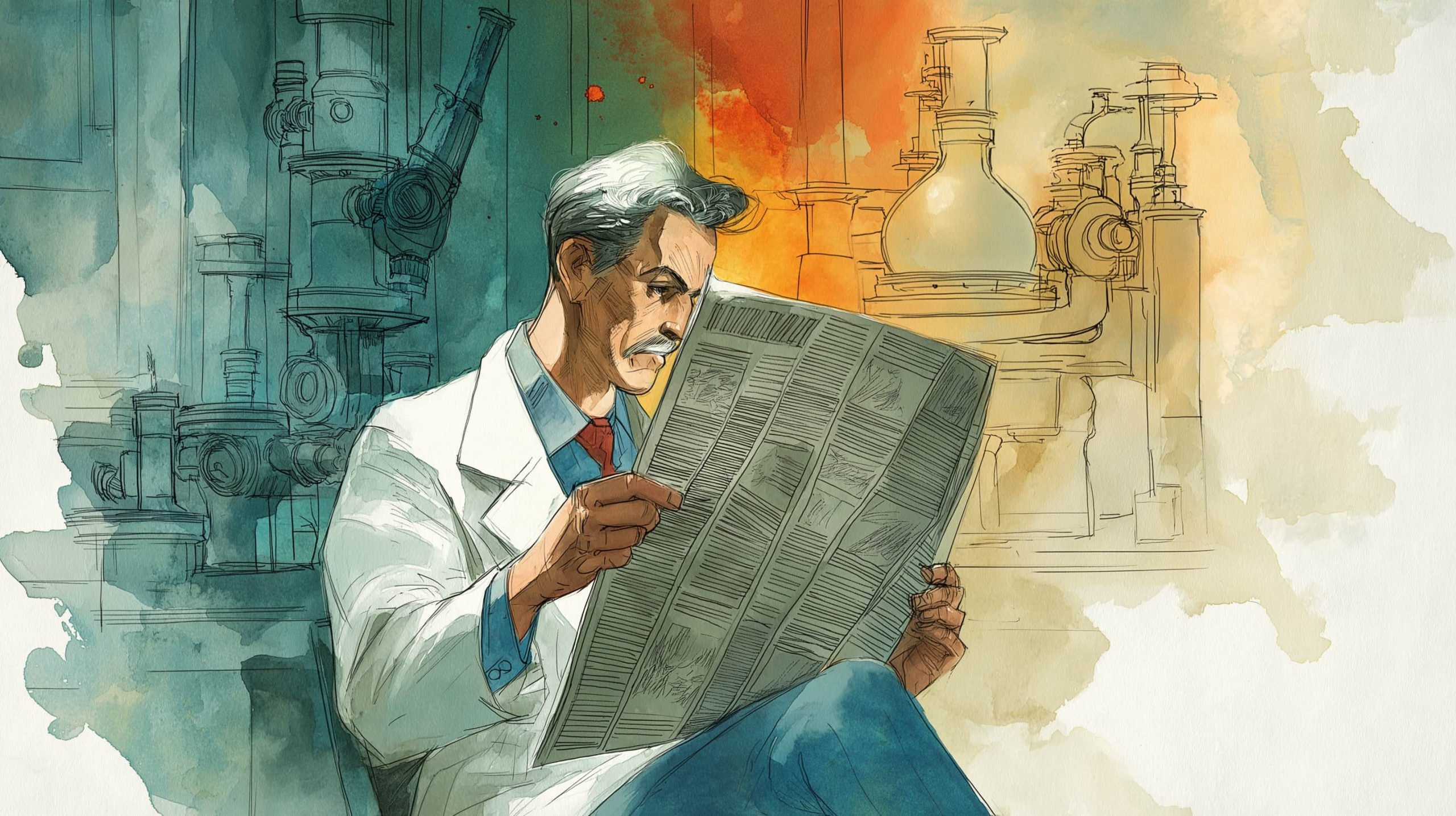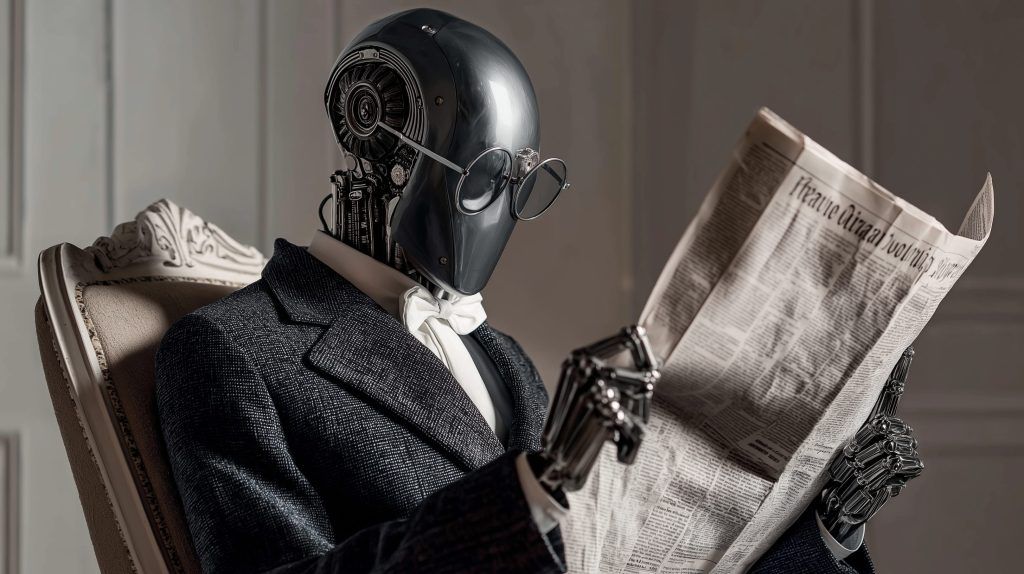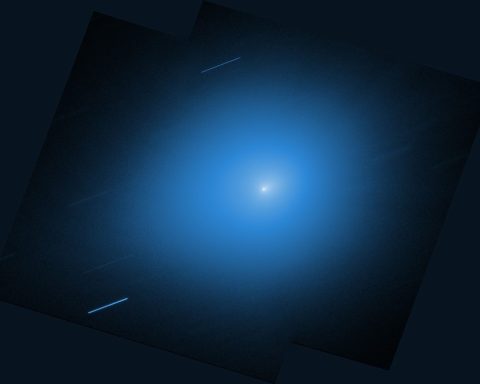Space Exploration & Astronomy
- Webb Telescope Discovers a New Moon Around Uranus: NASA’s James Webb Space Telescope has identified a previously unknown moon orbiting Uranus, bringing the planet’s tally to 29 [1]. The tiny moon (about 10 km across) escaped Voyager 2’s detection nearly 40 years ago, showcasing Webb’s powerful infrared vision. “No other planet has as many small inner moons as Uranus, and their complex inter-relationships with the rings hint at a chaotic history… making it likely that even more complexity remains to be discovered,” said Dr. Matthew Tiscareno of the SETI Institute, a member of the discovery team [2]. The finding underscores how modern astronomy builds on Voyager’s legacy, revealing new details of Uranus’s rings-and-moons system [3].
- “Eye of Sauron” Blazar’s Hidden Engine Revealed: Astronomers peered into the heart of a distant blazar nicknamed the “Eye of Sauron” (PKS 1424+240) and unraveled a 15-year mystery. Using ultra-precise radio imaging from the VLBA, the team found a nearly perfect ring-shaped (toroidal) magnetic field powering a jet aimed straight at Earth [4]. This explains how the sluggish-looking jet can still fire off high-energy neutrinos and gamma rays. “When we reconstructed the image, it looked absolutely stunning… We have never seen anything quite like it,” said lead author Dr. Yuri Kovalev of the Max Planck Institute for Radio Astronomy [5]. The result confirms that magnetic fields around supermassive black holes can accelerate particles to extreme energies, solving the puzzle of the blazar’s intense emissions [6].
- Jupiter’s Aurora Yields Unusual Plasma Waves: Scientists analyzing data from NASA’s Juno spacecraft have detected a new type of plasma wave above Jupiter’s north pole [7]. Jupiter’s polar magnetosphere, with its extremely low plasma density and powerful magnetic field, hosts ultra-low-frequency waves unlike anything seen near Earth. “While plasma can behave like a fluid, it is also influenced by its own magnetic fields and external fields,” explained Prof. Robert Lysak of the University of Minnesota. “Our study sheds light on how Jupiter’s complex magnetic field allows particles to flood into the polar cap, unlike Earth where the aurora forms a donut pattern around the pole” [8]. The discovery, published in Physical Review Letters, opens a new window into Jovian space weather and auroral physics [9] [10].
Medical Research & Biotechnology
- Experimental “Universal” Antiviral Shows Promise: Columbia University scientists report an mRNA-based therapy that broadly boosts antiviral defenses in lab animals [11]. Inspired by a rare immune disorder (ISG15 deficiency) that makes people nearly impervious to viruses, the team’s nanoparticle-delivered messenger RNAs trigger cells to produce a set of 10 proteins that put the body in an antiviral “ready” state [12] [13]. In tests, the treatment prevented replication of influenza and SARS-CoV-2 in mice and hamsters, dramatically reducing disease severity [14]. “In cell culture, we have yet to find a virus that can break through the therapy’s defenses,” said Dr. Dusan Bogunovic, the immunologist leading the work [15]. The approach, published in Science Translational Medicine, could one day arm first-responders and vulnerable populations against new pandemics [16].
- mRNA Cancer Vaccine Wipes Out Tumors in Mice: University of Florida researchers have developed a novel mRNA cancer vaccine that, when paired with standard immunotherapy (PD-1 checkpoint inhibitors), eradicated aggressive tumors in mouse models [17] [18]. Unlike typical cancer vaccines that target specific tumor antigens, this shot supercharges the immune system broadly – essentially tricking the body into attacking cancer as if it were a virus [19]. “This paper describes a very unexpected and exciting observation: that even a vaccine not specific to any particular tumor or virus… could lead to tumor-specific effects,” said Dr. Elias Sayour, the study’s senior author and pediatric oncologist [20]. In some mice, tumors regressed with the vaccine alone, hinting at a possible off-the-shelf therapy effective against multiple cancer types [21] [22]. The breakthrough, published in Nature Biomedical Engineering, fast-tracks plans for human trials to see if the approach can “wake up” the immune system to fight cancers in patients [23] [24].
Environmental Science
- Great Salt Lake Rewired by Human Decisions: A new geoscience study reveals that Utah’s Great Salt Lake entered an unprecedented state in the past 150 years due to two major human interventions [25] [26]. By analyzing oxygen and carbon isotope ratios in lakebed sediments, University of Utah researchers showed the lake was stable for millennia but shifted dramatically after Mormon settlers began irrigating the watershed in 1847, and again when a railroad causeway split the lake in 1959 [27]. “We see a big shift in the carbon isotopes, and it shifts from values indicative of rock weathering… toward more organic sources,” said Prof. Gabriel Bowen, referring to the surge of nutrients and carbon from 19th-century farming [28]. Likewise, the causeway fundamentally altered water flow and salinity – changes “rarely seen in thousands of years” – essentially pushing the lake into a new ecological regime [29] [30]. The findings, published in Geophysical Research Letters, provide crucial context as the drought-stricken lake hovers near record lows and inform targets for managing its fragile ecosystem [31] [32].
Climate Change
- Rising Seas Threaten Easter Island’s Heritage: Scientists warn that by 2080, climate change could endanger the iconic moai statues and sacred sites of Rapa Nui (Easter Island) [33] [34]. A University of Hawai‘i-led study used advanced simulations to model how sea-level rise will drive powerful waves farther inland. The famous Ahu Tongariki altar, which holds 15 massive moai, could be regularly flooded by high waves within decades [35]. “This research reveals a critical threat to the living culture and livelihood of Rapa Nui,” said lead author Noah Paoa, a Rapa Nui native and Earth sciences doctoral student. “For the community, these sites are an essential part of reaffirming identity… Failure to address this threat could ultimately endanger the island’s UNESCO world heritage site status” [36]. Beyond the cultural loss, the damage would hit the island’s tourism-dependent economy. Experts urge proactive adaptation measures to protect Rapa Nui’s coastline – a rallying cry that echoes for other vulnerable Pacific heritage sites facing rising oceans [37] [38].
Artificial Intelligence
- Nvidia Develops Advanced AI Chip for China Amid Export Curbs: In tech news, chipmaker Nvidia is reportedly designing a new AI processor (code-named “B30A”) for the Chinese market that would outclass its current H20 model [39]. The work-around chip is based on Nvidia’s latest Blackwell architecture but tailored to comply with U.S. export restrictions on high-end AI hardware. Nvidia hopes to deliver prototype units to Chinese clients as early as next month [40]. However, approval is uncertain – Washington remains wary of giving China access to top-tier AI technology [41]. U.S. President Donald Trump recently signaled he may allow more advanced Nvidia sales to China, but no decision has been finalized [42]. Commerce Secretary Howard Lutnick noted the company’s persistence: “Of course [CEO Jensen Huang] would like to sell a new chip to China… I’m sure he’s pitching the president all the time” [43]. Nvidia stated that all its products follow government rules and are “designed solely for beneficial commercial use” [44]. The development highlights the geopolitical tightrope around AI and semiconductors, as industry leaders push for market access while officials balance economic interests with security concerns.
Energy
- “Dead” Lithium Batteries Seen as Green Gold Mine: New research out of Edith Cowan University (Australia) finds that recycling spent lithium-ion batteries could save billions of dollars and drastically cut pollution [45] [46]. With electric vehicle and storage battery use surging, global lithium demand is projected to quadruple from 2020 to 2026 [47]. Yet most discarded EV batteries still retain ~80% of their lithium content [48]. The study argues that building a robust recycling industry would reclaim valuable materials (lithium, nickel, cobalt) and curb the need for environmentally intensive mining [49] [50]. “By recycling these batteries, you can access not only the remaining lithium – which [is] already purified to near 99% – but you can also retrieve the nickel and the cobalt from these batteries,” said co-author Asad Ali, noting estimates that Australia’s battery recycling sector could be worth up to $3.1 billion annually within a decade [51] [52]. Recycling dramatically reduces land use, water consumption, and carbon emissions – up to 61% less CO₂ and 83% less energy used compared to mining for new lithium [53] [54]. The authors call for investment in recycling infrastructure and pro-recycling policies, as current innovation is outpacing regulations on battery end-of-life management [55] [56].
Physics
- Gold Heated Hotter Than the Sun – And It Stayed Solid: In a startling physics breakthrough, researchers managed to heat a piece of gold to over 19,000 K (~33,740°F) – more than 14 times its normal melting point – without it liquefying [57] [58]. The team, led by University of Nevada physicists, blasted a thin gold foil with an ultrafast laser pulse at SLAC National Accelerator Lab, then probed it with X-ray lasers to measure atomic vibrations [59] [60]. The gold’s crystal lattice withstood an “entropy catastrophe” threshold long thought to force any solid to melt when heated >3× its melting temperature [61]. “This is possibly the hottest crystalline material ever recorded,” said lead author Dr. Thomas White, describing how the experiment upends a century-old theory [62]. By superheating gold in just 50 quadrillionths of a second, the team found that rapid energy delivery can prevent melting – a discovery with implications for fusion research and planetary science [63] [64]. A staff scientist at SLAC, Bob Nagler, noted this provides the first direct method to take temperature inside extremely dense plasmas, “poised to make a transformative contribution” to understanding inertial fusion conditions [65]. The findings, published in Nature, open new frontiers in high-energy-density physics and could improve how we measure and control matter under extreme conditions [66] [67].
Sources: The above information is drawn from recent press releases, journal publications, and reports dated August 19–20, 2025, including NASA announcements [68] [69], ScienceDaily and Sci-News summaries [70] [71], university press releases [72] [73], Reuters newswire reports [74], and peer-reviewed study findings [75] [76]. All content has been verified for accuracy as of August 20, 2025.
References
1. science.nasa.gov, 2. science.nasa.gov, 3. science.nasa.gov, 4. www.sciencedaily.com, 5. www.sciencedaily.com, 6. www.sciencedaily.com, 7. www.sci.news, 8. www.sci.news, 9. www.sci.news, 10. www.sci.news, 11. www.sciencedaily.com, 12. www.sciencedaily.com, 13. www.sciencedaily.com, 14. www.sciencedaily.com, 15. www.sciencedaily.com, 16. www.sciencedaily.com, 17. www.sciencedaily.com, 18. www.sciencedaily.com, 19. www.sciencedaily.com, 20. www.sciencedaily.com, 21. www.sciencedaily.com, 22. www.sciencedaily.com, 23. www.sciencedaily.com, 24. www.sciencedaily.com, 25. www.sciencedaily.com, 26. www.sciencedaily.com, 27. www.sciencedaily.com, 28. www.sciencedaily.com, 29. www.sciencedaily.com, 30. www.sciencedaily.com, 31. www.sciencedaily.com, 32. www.sciencedaily.com, 33. scitechdaily.com, 34. scitechdaily.com, 35. scitechdaily.com, 36. scitechdaily.com, 37. scitechdaily.com, 38. scitechdaily.com, 39. www.reuters.com, 40. www.reuters.com, 41. www.reuters.com, 42. www.reuters.com, 43. www.reuters.com, 44. www.reuters.com, 45. www.sciencedaily.com, 46. www.sciencedaily.com, 47. www.sciencedaily.com, 48. www.sciencedaily.com, 49. www.sciencedaily.com, 50. www.sciencedaily.com, 51. www.sciencedaily.com, 52. www.sciencedaily.com, 53. www.sciencedaily.com, 54. www.sciencedaily.com, 55. www.sciencedaily.com, 56. www.sciencedaily.com, 57. scitechdaily.com, 58. scitechdaily.com, 59. scitechdaily.com, 60. scitechdaily.com, 61. scitechdaily.com, 62. scitechdaily.com, 63. scitechdaily.com, 64. scitechdaily.com, 65. scitechdaily.com, 66. scitechdaily.com, 67. scitechdaily.com, 68. science.nasa.gov, 69. science.nasa.gov, 70. www.sciencedaily.com, 71. www.sci.news, 72. www.sciencedaily.com, 73. www.sciencedaily.com, 74. www.reuters.com, 75. www.sciencedaily.com, 76. scitechdaily.com










